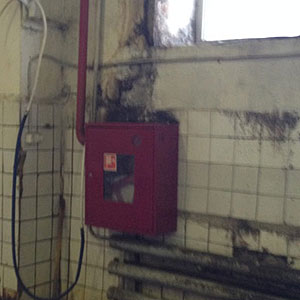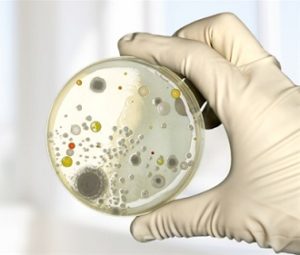
Insects and molds cause defects in substratum and reduced yields of oyster mushrooms.
The most effective way to deal with midges, mosquitoes, mold in mushroom production is an integrated approach, but not only chemicals.
All rooms must be plastered, window frames, doors and doorways repaired so that there are no gaps. Insects and mold spores breed in these places.
There is no need to paste over the walls with insulating materials with foil - condensation collects between this material and the walls and mold multiplies. Disinfection with fungicides does not help in this case.
Mold does not live in the grow room, even at high humidity, if the ventilation creates good air exchange.
There is no need to use chemistry "just in case" (as a precaution). It is harmful to people's health and to the operation of the enterprise.
Frequent treatments kill weak strains of microorganisms and those that do not interfere with the development of oyster mushroom mycelium.
Aggressive strains of mold come to this free space and compete with oyster mushrooms. Because of this, mold spores enter the substrate and oyster mushroom mycelium cannot colonize it.
That is, the unreasonable use of disinfection leads to the opposite result.
Let's look at what chemicals are used to cultivate oyster mushrooms.
Table of Contents:
A 40% solution of formaldehyde in water containing 8% methyl alcohol is called formalin.
I believe that it is not acceptable to use formalin in the production of oyster mushrooms.
Firstly, oyster mushrooms, unlike champignon, are practically not affected by mold fungi.
Secondly, it is too poisonous and causes many long-term side effects. What does "remote effect" mean? If you get sick with allergies, bronchitis or skin rashes six months after using formalin, you are unlikely to attribute this to the fact that you once worked with formalin.
In addition, formaldehyde has a carcinogenic effect. This does not mean that you will instantly get cancer. But if you work with formaldehyde from year to year, there is an accumulation of poison in the body, and the immune system can not stand it.
If you disinfect once a season, there will be no mold in the growing chamber.
 Disinfectants not only kill molds, but unlike fungicides, they also destroy many types of viruses and bacteria.
Disinfectants not only kill molds, but unlike fungicides, they also destroy many types of viruses and bacteria.
These preparations are not addictive to microorganisms. Many of them are also active against spores.
It is necessary to select chemicals that are non-toxic or low-toxic for people, since the processing takes place in closed rooms.
By what criteria do we find the best disinfectant? It is important for us that it destroys mold and bacteria spores and is safe for people and the environment.
I have repeatedly heard the opinion of mushroom growers that it is necessary to use the same products that are used in operating rooms in hospitals.
But this is not true. We have no need to destroy viruses that are dangerous to humans, or, for example, Staphylococcus aureus or the tuberculosis bacillus.
It is important for us that the chemicals have a sporicidal effect on mold spores, since they are the ones that most harm the substrate and the development of oyster mushroom mycelium.
For the treatment of all premises, chemical preparations containing one of the active substances are used:
You can also use the VIROCID disinfectant.
You can find the name of the drug that is produced in your country by the active ingredient listed above.
Disinfectants are used to treat the ventilation system, filter, air ducts by aerosol spray.
To do this, the ventilation system is turned on for full recirculation, the exhaust fan is turned off. Diluted according to the instructions, the substance is introduced into the water supply system for humidification. This system must be built into the ventilation system.
If you use a different method of moisturizing, the diluted preparation can be sprayed near the recirculation hole with the ventilation turned on.
Use a gas mask and chemical protection suit!
Consider sequentially all production areas and the need for their disinfection.
 Immediately after the process, carry out a complete wet cleaning of all rooms in the clean area with the addition of Domestos-type detergents to the water.
Immediately after the process, carry out a complete wet cleaning of all rooms in the clean area with the addition of Domestos-type detergents to the water.An hour or two before starting work, disinfect the clean area using a hand sprayer with 5% hydrogen peroxide, which is prepared from a concentrated solution that you can buy in the online store. It must be diluted with water in such a proportion to obtain a 5% solution.
Peroxide destroys spores quite efficiently - when it gets on them, the hydrogen peroxide molecule decomposes with the release of active atomic oxygen, which destroys the spores.
To disinfect a room with a chlorine-containing preparation, it is best to use Domestos (or Clorox). Although it does not act on all spores, it kills spores without shells and swollen spores.
Three caps of this product should be diluted in 7 liters of water, and the room should be sprayed with a hand sprayer.
It contains surfactants that prolong its action.
If your country does not have this product, find a composition similar to it.
It contains 100 thousand ppm, which is (10%) the active component chlorine, or 5% sodium hypochlorite (NaOCl), as well as 10% surfactants of two types.
Other brands that have the same formula are Domex, Glorix and Klinex
Dilute and process very carefully, wearing gloves, a respirator and closed clothing. The peroxide solution leaves chemical burns on the skin and mucous membranes.
Spray with a sprayer that has a telescopic rod, keeping it as far away from you as possible. Move from the far corner to the exit, treating the walls, floor and surfaces in the room.
What other disinfectants can be used - read here.
If you follow all the above recommendations, and you have no problems with mold and insects at your enterprise, it is enough to disinfect the premises once a season.
You can combine minor annual repairs with disinfection in the summer.
Every two or three seasons, be sure to change the polyethylene air ducts.
It does not make sense to use foundationazole, and other anti-mold products with benomyl during heat treatment of the substrate. Since they decompose in an alkaline environment.
